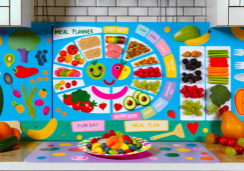Beginner's Guide to Low-Carb Meal Planning
As you weigh your options, consider your health, and contemplate a change in your diet, you might find yourself intrigued by the low-carb lifestyle that's been the buzz of nutrition circles. You're not alone in your quest to understand how reducing carbohydrates can lead to a healthier you.
The journey to effective low-carb meal planning can be smooth with the right guidance, but it's easy to get lost in the sea of information available. You'll need to know which foods are your allies, which cravings to combat, and how to keep your meals varied and satisfying without feeling deprived.
Stay tuned, as we're about to unveil the essentials that will help you craft a meal plan that suits not just your dietary goals, but also your taste buds and lifestyle.
Understanding Low-Carb Diets
When embarking on a low-carb diet, you're essentially cutting back on carbohydrates to focus on higher protein and fat intake, which can lead to health benefits such as weight loss and improved diabetes management.
Low-carb diets vary in the grams of carbohydrates per day they allow, but typically, you'll consume between 20-100 grams to maintain a state that supports your goals, whether it's achieving ketosis in ketogenic diets or simply reducing carb intake in low carbohydrate diets.
Contrary to some misconceptions, natural fats aren't your enemy on this eating plan. Instead, you'll minimize sugars and starches, which your body often stores as fat. By reducing carbohydrate consumption, you may see a reduction in blood sugar levels, which is particularly beneficial in managing type 2 diabetes mellitus.
If you're plotting out a low carb meal plan, remember that it's not just about slashing carbs; it's about replacing them with nutritious alternatives. Initially, you might experience side effects like the 'keto flu,' but these can typically be mitigated through proper hydration and salt intake.
Essential Low-Carb Foods
Now that you understand the basics of low-carb diets, let's focus on the foundational foods that will make up the majority of your meals. When creating your low-carb meal plan, you'll want to aim for a certain number of carbs per day, typically between 20-50 grams of net carbs, depending on your personal goals.
Here's a list of low carb foods to keep in mind:
- Proteins
- Meat: Beef, pork, lamb, and other varieties
- Fish: Salmon, trout, and sardines are great fatty fish options
- Eggs: Opt for whole, organic eggs when possible
- Fats and Oils
- Natural fats: Avocado, olives, and coconut oil
- Nuts and seeds: Almonds, walnuts, and flaxseeds
Vegetables that grow above ground are also low in carbs and can be incorporated liberally to add volume and nutrients to your meals. While planning your personalized meal plan, remember to minimize sugar and starchy foods like bread and pasta, which are high in carbs. Always read food labels to avoid hidden sugars.
And don't forget, pairing your diet with regular physical activity can enhance its benefits, making those delicious low carb recipes part of a balanced approach to eating on a low carbohydrate diet.
Planning Your Meals
To embark on your low-carb journey effectively, it's essential to plan your meals with a balance of protein, healthy fats, and low-carb vegetables, ensuring a nutrient-rich diet that aligns with your goals.
When crafting your meal plan, aim for variety to keep things interesting. Explore carb recipes to choose from that excite your palate while keeping you within your macros.
Creating a meal prep routine can't only save you time but also help you make healthier eating choices throughout the week. If you're considering keto meal plans, remember they're typically lower in carbs and higher in fats, so adjust your grocery list accordingly. It's crucial to eat low in carbs but also to monitor your calories per day to maintain or achieve your desired weight.
Ensure each meal includes a good portion of grams of protein to help with satiety and muscle maintenance. Choose whole foods that are low in carbs, and be mindful of getting enough nutrients. This balance is vital for sustaining energy and overall health.
Lastly, be flexible with your meal plan. Listen to your body's responses and adjust as needed. Remember, a successful low carb diet is one that's sustainable and tailored to your unique needs.
Overcoming Common Challenges
How can you tackle the hurdles that come with adjusting to a low-carb lifestyle without compromising on nutrition and flavor? Overcoming common challenges in a low carb challenge often revolves around knowing what to eat and how to plan effectively.
Here are some helpful tips to make the transition smoother and ensure you feel satisfied:
- Planning Ahead:
- *Meal Plans Designed for Success:* Craft your week with meal plans that focus on variety, ensuring you get a balance of protein, fats, and low-carb vegetables.
- *Prep and Store:* Prepare snacks and meals in advance to resist the temptation of high-carb options.
- Smart Snacking:
- *Healthy Fats and Proteins:* Choose snacks rich in natural fats and proteins to curb hunger without a carb spike.
- *Need to Snack Smartly:* Keep low-carb snacks on hand so you don't fall prey to convenience foods.
Maintaining a Low-Carb Lifestyle
Embracing a low-carb lifestyle means prioritizing protein, natural fats, and an array of non-starchy vegetables to maintain health and manage weight effectively. When you're meal planning, consider your individual needs for carbohydrates per day, which can vary depending on your activity level and health goals. A low carb diet, often recommended by registered dietitians, typically includes foods like lean meats, fish, eggs, dairy, nuts, seeds, and oils such as olive oil.
For sustainable weight loss and optimal eating habits, it's crucial to balance your meals with these macronutrients. Fat, once demonized, is now understood to be essential, especially the healthier ones found in olive oil and avocados. These fats can help keep you full and satisfied.
Incorporate creative substitutes like cauliflower rice to keep meals interesting and nutritionally rich without overloading on carbs. Eating a variety of foods ensures you're not missing out on essential nutrients. Remember to stay hydrated and be mindful of hidden carbs in sauces and dressings.
A low-carb lifestyle isn't only about weight loss; it's about making informed choices that benefit your overall health. With careful meal planning and an understanding of the role each food plays, you can enjoy a fulfilling and healthful way of eating.
Frequently Asked Questions
How Do I Start a Low-Carb Diet for Beginners?
Start by learning macronutrient ratios and reading labels to understand carb counts. Focus on hydration, and choose healthy fats. Practice portion control, use carb substitutes, and plan meals with carb cycling and meal timing in mind.
What Can You Eat the First Week of a Low-Carb Diet?
In your first low-carb week, prioritize protein sources like meat and eggs, enjoy ketogenic breakfasts, and choose healthy fats. Hydrate well, consider sugar substitutes, and explore a variety of vegetables for balanced meals.
What Are 5 Foods to Avoid on Low-Carb Diet?
You'll want to avoid sugar-sweetened beverages, white bread, high-starch vegetables, tropical fruits high in sugars, and sweetened yogurts due to their hidden sugars and refined carbs, which can disrupt your low-carb goals.
What Is the Number 1 Carb to Avoid?
You should avoid sugar, considering its impact on starch digestion and the glycemic index. Understand complex carbs, and don't let dietary fiber confusion or net carbs concepts mislead you from your low-carb goals.
Conclusion
You've got the basics down, and your kitchen's stocked with low-carb essentials. Remember, planning is key to avoiding pitfalls and keeping meals exciting.
Stick to your meal plan, but don't be afraid to mix things up to suit your taste and lifestyle. By staying informed and flexible, you'll navigate challenges and maintain this healthful approach with ease.
Keep it balanced, listen to your body, and enjoy the journey to a more vibrant, low-carb life.










